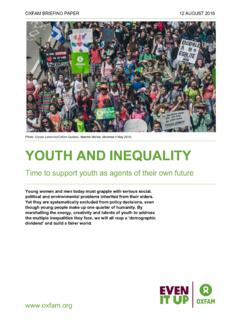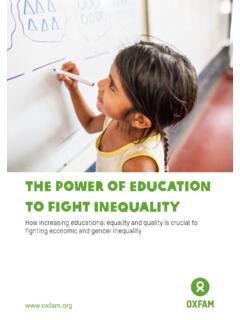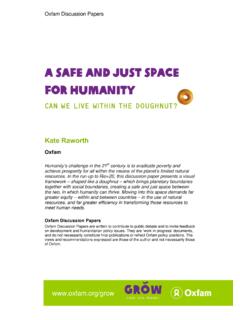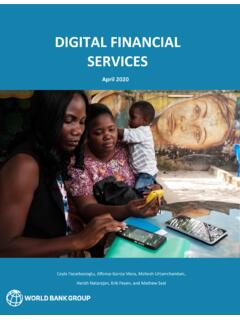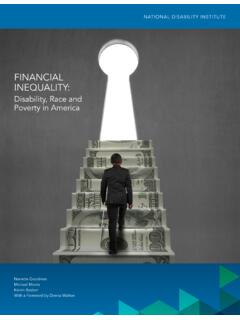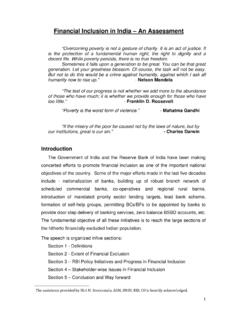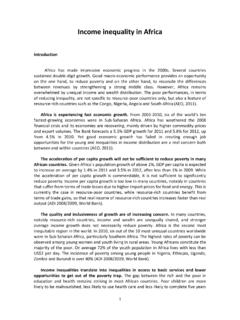Transcription of Photo: Moshood Raimi/Oxfam
1 Photo: Moshood Raimi/OxfamThis report was written and coordinated by Emmanuel Mayah, an investigative journalist and the Director Reporters 360, Chiara Mariotti (PhD), inequality Policy Manager, Evelyn Mere, who is Associate Country Director Oxfam in nigeria and Celestine Okwudili Odo, Programme Coordinator Governance, Oxfam in NigeriaSeveral Oxfam colleagues gave valuable input and support to the finalisation of this report, and therefore deserve special mention. They include: Deborah Hardoon, Nick Galasso, Paul Groenewegen, Ilse Balstra, Henry Ushie, Chioma Ukwuagu, Safiya Akau, Max Lawson, Head of inequality Policy Oxfam International, and Jonathan Mazliah.
2 A former Oxfam partners also made invaluable contributions in the campaign strategy development and report review process. We wish to thank BudgIT Information Technology Network; National Association of nigeria Traders (NANTS),Civil Society Legislative Advocacy Centre (CISLAC), Niger Delta Budget Monitoring Group (NDEBUMOG, KEBETKACHE Women Development and Resource Centre and the African Centre for Corporate Responsibility (ACCR). Ruona J. Meyer and Thomas Fuller did an excellent job editing the report, while the production process was given a special touch by BudgIT Information Technology Network, our inequality Campaign Oxfam International May 2017 This publication is copyright but the text may be used free of charge for the purposes of advocacy, campaigning, education, and research, provided that the source is acknowledged in full.)
3 The copyright holder requests that all such use be registered with them for impact assessment purposes. For copying in any other circumstances, or for re-use in other publications, or for translation or adaptation, permission must be secured and a fee may be charged. Email information in this publication is correct at the time of going to is an international confederation of 20 organizations networked together in more than 90 countries, as part of a global movement for change, to build a future free from the injustice of poverty . Please write to any of the agencies for further information, or visit Summary Introduction Scale of Economic and Gender inequality in NigeriaRetrogressive Taxation: nigeria 's poor taxed heavily, its rich lightly Elite Capture, Cronyism and Favouritism Undermine Policies that Encourage InclusionThe Prohibitive Cost of Governance, income inequality and theMisapplication of Scarce Resources Reducing inequality through Policy and Political Choices Notes 12345021226 Contents 314722 EXECUTIVE SUMMARY04#EvenItUpEXECUTIVE SUMMARYD espite the prevailing recession nigeria is still seen as Africa s largest economy and one of the fastest-growing in the world.
4 Yet, more than half of the Nigerian population still grapples with extreme poverty , while a small group of elites enjoys ever-growing wealth. This report provides a picture of the current state of poverty and economic inequality in nigeria , identifies the main drivers of this situation and presents some policy the past 40 years, the gap between the rich and the poor has been growing in 1developed and developing countries alike. In 2015, just 62 people had as much wealth as the poorest half of humanity, and the richest one percent owned more 2wealth than the rest of the world combined. At the same time, the poorest people are being denied their fair share: since the turn of the century, the poorest half of the world s population has received just one percent of the total increase in global 3wealth.
5 in nigeria the scale of economic inequality has reached extreme levels, and it finds expression in the daily struggles of the majority of the population in the face of accumulation of obscene amounts of wealth by a small number of individuals. 4 While more than 112 million people were living in poverty in 2010, The richest 5 Nigerian man will take 42 years to spend all of his wealth at 1 million per day. According to Oxfam s calculations, the amount of money that the richest Nigerian man can earn annually from his wealth is sufficient to lift 2 million people out of 6poverty for one year. Lifting all Nigerian people living below the extreme poverty line of $ out of poverty for one year will cost about $24 billion.
6 This amount of money is just lower than the total wealth owned overall by the five richest Nigerians in 2016, which was equal to $ in nigeria is particularly outrageous because it has been growing in the context of an expanding economy where the benefits have been reaped by a minority of people, and have bypassed the majority of the population. Annual 8economic growth averaged over 7% in the 2000s, and yet nigeria is one of the few African countries where both the number and the share of people living below the national poverty line over that period, increased from 69 million in 2004 to 112 in 2010, equivalent to 69% of the population. In the same period the number of millionaires increased by approximately 44%.
7 income inequality , as measured by 9the Gini Index, grew from 40% in 2003 to 43% in inequality is high in nigeria , and it translates into higher rates of poverty in the north-western states of the country. For example, in Sokoto State, 81% of the population is poor, while poverty incidence is much lower, at 34%, in Niger. Economic and gender inequality are interconnected and reinforce each other. The life of Nigerian women is affected by a myriad of discriminatory traditional and socio-cultural practices that put them at disadvantage in a number of areas compared to men. For example, the majority of women are employed in casual, low-skilled, low-paid informal jobs; women are less likely than men to own land and of the poorest women have never been to school, compared to 28% of 10richest men.
8 In Jigawa State, 94% of women (against 42% of men) are illiterate. As a result of these disadvantages, women are more likely to be poor than men, and keep being excluded from full participation in the country s economic, social and political amount of money that the richest Nigerian man can earn annually from his wealth is sufficient to lift 2 million people out of poverty for one share of Nigerians living below the poverty line increased from 69 million in 2004 to 112 in 2010, equivalent to 69% of the population. 1 Oxfam (2014). Even it Up: Time to End Extreme poverty . 2 Oxfam (2016). An Economy for the 1%: How privilege and power in the economy drive extreme inequality and how this can be stopped.
9 Retrieved from 3 Ibidem4 NBS National Bureau of Statistics (2012) nigeria poverty Profile 2010 .5 Based on data from Forbes 2016 ranking of the World s This figure is obtained comparing the income stream that the richest Nigerian can earn from his wealth with the absolute value of the poverty gap (multiplied by 365 days), using the $ extreme poverty line. Earnings on wealth are estimated using an interest rate of 4%, corresponding to the growth rate of wealth of HNWI (high net worth individuals) in 2015 according to CapGemini's 2016 World Wealth According to Oxfam's calculations based on Povcal data, $ billion would be necessary to lift every poor person up to the $ extreme poverty line Bank (WB), (2013).
10 nigeria Economic Report . World Bank, nigeria Economic Report Development Indicators10 British Council (2012). 'Gender in nigeria Report 2012: Improving the lives of girls and women in nigeria .2m20102004 Poor Nigerians69m112mThe life of Nigerian women is affected by a myriad of discriminatory, traditional, socio cultural majority of women are employed in casual, low-skilled, low-paid informal jobs, women are less likely to own land, of the poorest women have never been to school. As a result of these disadvantages, women are more likely than men to be poor. 05#EvenItUp11 Nigerian lawmakers top salaries chart,via: $20trn stolen from nigeria s treasury by leaders EFCC- to N257 billion, see : How MTN ships billions abroad, paying less tax in nigeria , (Premium Times), 2015, special- of data is Oxfam s Commitment to Reduction of inequality 1960 and 2005, about $20 trillion was stolen from the treasury by public office holders.
